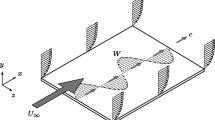Abstract
Control strategies for laminar flow control above an unswept wing are investigated. An actuation method based on a flexible membrane displaced by multiple piezo-polymer composite elements is developed for wind tunnel experiments. A model predictive control algorithm is applied to control the multi-bar actuator. The direct negative superposition method of damping Tollmien–Schlichting waves is compared to a biomimetic approach imitating the damping mechanisms of a compliant skin. In both cases, a model predictive control algorithm is applied to control the multi-bar actuator segments. For the biomimetic approach, reduced, real-time solvable models of compliant surfaces are developed and parametrized by direct optimization and according to numerically generated optimal wall properties. Damping results of up to 85 % RMS value are achieved, shifting the onset of transition about 100 mm downstream with a single actuation membrane. Additional experiments with cascaded multiple membranes show the potential for a further shift.















Similar content being viewed by others
Notes
For two scalar discrete time series x 1, x 2 we define the fit as \(1-(\|x_1-x_2 \| / \|x_2-\hbox{mean}(x_2)\|)\)
References
Åström KJ (1980) Maximum likelihood and prediction error methods. Automatica 16(5):551–574
Ahuja S, Rowley C (2010) Feedback control of unstable steady states of flow past a flat plate using reduced-order estimators. J Fluid Mech 645:447–478
Bagheri S, Henningson D (2011) Transition delay using control theory. Philos Trans R Soc A Math Phys Eng Sci 369(1940):1365
Bagheri S, Brandt L, Henningson DS (2009) Input-output analysis, model reduction and control of the flat-plate boundary layer. J Fluid Mech 620:263–298
Baumann M, Nitsche W (1996) Investigation of active control of Tollmien-Schlichting waves on a wing. In: Henkes R, van Ingen J (eds) Transitional boundary layers in Aeronautics. KNAW, Amsterdam, pp 89–90
Bewley T, Liu S (1998) Optimal and robust control and estimation of linear paths to transition. J Fluid Mech 365:305–349
Carpenter P, Garrad A (1985) The hydrodynamic stability of flow over Kramer-type compliant surfaces. Part 1. Tollmien-Schlichting instabilities. J Fluid Mech 155:465–510
Carpenter P, Morris P (1990) The effect of anisotropic wall compliance on boundary-layer stability and transition. J Fluid Mech 218:171–223
Chughtai S, Werner H (2012) Modeling and distributed control of transition in plane poiseuille flow. IEEE Trans Control Syst Tech 20(3):755–762
Davies C, Carpenter P (1997) Numerical simulation of the evolution of Tollmien-Schlichting waves over finite compliant panels. J Fluid Mech 335:361–392
Evert F, Ronneberger D, Grosche FR (2000) Application of linear and nonlinear adaptive filters for the compensation of disturbances in the laminar boundary layer. ZAMM 80:85–88
Fukagata K, Kern S, Chatelain P, Koumoutsakos P, Kasagi N (2008) Evolutionary optimization of an anisotropic compliant surface for turbulent friction drag reduction. J Turbul 9:1–17
Goldin N, King R (2012) Learning from dolphin skin—drag reduction by active delay of transition: flow control by distributed wall actuation. In: Tropea C, Bleckmann H (eds) Nature-inspired fluid mechanics, notes on numerical fluid mechanics and multidisciplinary design, vol 119. Springer, New York, pp 207–222
Gray J (1936) Studies in animal locomotion: VI. The propulsive powers of the dolphin. J Exp Biol 13:192–199
Gad-el Hak M (2000) Flow control: passive, active, and reactive flow management. Cambridge University Press, Cambridge
Haller D (2011) Piezo-polymer-composite actuators—design, nonlinear characterization and application for active cancellation of flow instabilities. PhD thesis, IMTEK, Universität Freiburg
Haller D, Pätzold A, Losse N, Neiss S, Peltzer I, Nitsche W, King R, Woias P (2011) Piezo-polymer-composite unimorph actuators for active cancellation of flow instabilities across airfoils. J Intel Mat Syst Str 22(5):465–478. doi:10.1177/1045,389X10395,794
Joshi S, Speyer J, Kim J (1997) A systems theory approach to the feedback stabilization of infinitesimal and finite-amplitude disturbances in plane Poiseuille flow. J Fluid Mech 332:157–184
King R, Aleksic K, Gelbert G, Losse N, Muminovic R, Brunn A, Nitsche W, Bothien M, Moeck J, Paschereit C, Noack BR, Rist U, Zengl M (2008) Model predictive flow control. In: 4th AIAA flow control conference, AIAA Paper 2008-3975
Kramer M (1960) The dolphins’ secret. New Sci 7:1118–1120
Li Y, Gaster M (2006) Active control of boundary-layer instabilities. J Fluid Mech 550:185–205
Lucey A, Carpenter P (1995) Boundary layer instability over compliant walls: comparison between theory and experiment. Phys Fluids 7:2355–2363
Maciejowski JM (2000) Predictive control with constraints. Prentice Hall, Harlow
Pavlov V (2006) Dolphin skin as a natural anisotropic compliant wall. Bioinsp Biomim 1:31–40
Sturzebecher D, Nitsche W (2003) Active cancellation of tollmien-schlichting instabilities on a wing using multi-channel sensor actuator system. Int J Heat Fluid Flow 24(4):572–583
Acknowledgments
The authors would like to thank the German Research Foundation (DFG) for funding this research as part of the SPP 1207 “Nature-Inspired Fluid Mechanics.” It is an adapted version of the SPP’s final report, published in Goldin and King (2012).
Author information
Authors and Affiliations
Corresponding author
Additional information
This article is part of the collection Topics in Flow Control. Guest Editors J. P. Bonnet and L. Cattafesta.
Rights and permissions
About this article
Cite this article
Goldin, N., King, R., Pätzold, A. et al. Laminar flow control with distributed surface actuation: damping Tollmien-Schlichting waves with active surface displacement. Exp Fluids 54, 1478 (2013). https://doi.org/10.1007/s00348-013-1478-6
Received:
Revised:
Accepted:
Published:
DOI: https://doi.org/10.1007/s00348-013-1478-6




